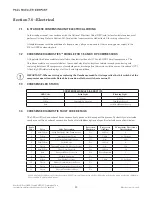
Mueller E-Star OESE 7.5 and 9 HP HFC Condensing Unit
Installation and Operation Manual, Part No. 8828748
Effective June 16, 2020
2.1 INSPECTION
Each shipment should be carefully checked for shortages or concealed damage. Any shortage or damage must be
reported to the delivery carrier at the time of delivery.
Damaged material becomes the delivery carrier’s responsibility and should not be returned to the manufacturer
unless prior approval is obtained.
2.2 HANDLING
IMPORTANT: Equipment used to move or lift this equipment must be rated for the weight of the
equipment. See Table 1 for equipment weight.
2.3 LOCATION
When choosing a location for the Mueller E-Star OESE condensing unit, consider these items:
•
Environment:
The unit must be located where it is protected from extreme temperatures of –30°F (–34.4°C)
and below or 115°F (46.1°C) and above.
•
Condenser Air Flow:
Ensure proper provisions for adequate air flow to the condenser. When installing the
condenser facing a wall, the distance to the wall must be a minimum of 24 in (61 cm) with non-restricted
air flow at the top, left, and right sides. Be especially cautious of installation methods that would allow the
condenser air flow to recirculate and conditions that would allow dust or oil to enter the condenser.
•
Serviceability:
The condensing unit should be located with the compressor and electrical enclosure
accessible for service. Do not pipe refrigerant lines in front of the electrical enclosure.
•
Efficiency:
Locate the condensing unit as close to the evaporator as possible. This will improve efficiency by
reducing pressure drop in the refrigerant piping.
•
Lubrication:
For proper oil return, do not install the condensing unit above the height of the evaporator, and
ensure the suction line returning from the evaporator is sloped towards the condensing unit.
2.4 REFRIGERATION PIPING AND EVACUATION
Refrigeration lines should be purged with dry nitrogen when brazing connections to prevent internal oxide
formation. Proper refrigerant practices as outlined in ASHRAE 15-1994 should be followed.
The refrigerant line set must be insulated to reduce heat gain, prevent sweating and condensation, and ensure
subcooled liquid refrigerant to the evaporator.
Refrigerant piping should be installed with long-radius bends or fittings.
E-Star condensing units are shipped with a dry nitrogen holding charge. The unit, refrigerant lines, and evaporator
circuit will require a triple system evacuation to 500 microns prior to refrigerant charging. The system must hold
below 1,000 microns in a standing vacuum test, ensuring that it is leak free.
NOTE:
Installation technicians must follow proper refrigerant practices as outlined in ASHRAE 15-1994.
3
Section 2.0 – Installation










































